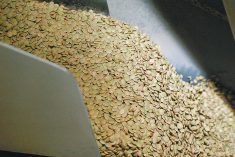At a time of record-setting soybean and corn crops, edible bean production in Canada and the United States has been declining.
That’s allowed bean prices to stay higher and more profitable than the big acreage North American crops.
“Generally, they’ve been firmer and have held the line in terms of lower production in the last few years,” said FarmLink Marketing Solutions’ Jonathon Driedger in a presentation at the Manitoba Special Crops Symposium.
He suggests farmers hold back sales in hope of small rallies in the coming months.
Read Also

Push for Hudson Bay port shouldn’t rob funds from existing export hubs
An expanded Port of Churchill would unlock the dream to end the Prairie’s land-locked status with its own northern coast gateway to the world.
“I think it’s worth waiting to see if we can’t get a couple more cents out of the market for most types.”
Combined Canada-U.S. dry bean production has gently declined to about 1.37 million tonnes from about 1.45 million in 2006. One of the biggest decliners is navy bean production, which has fallen from about 340,000 tonnes to about 210,000 tonnes. Black beans dropped dramatically between 2006 and 2007 and are now back to about their 2006 levels of nearly 145,000 tonnes.
Driedger suggested farmers wait for prices to climb about two cents per pound before selling old crop or contracting new crop.
Old crop pintos are fetching about 28 or 29 cents per lb., so producers could hold out for 30-31 cents. New crop bids have been around 30 cents and producers have a good shot at getting 32 cents, Driedger said.
Navies have a better chance at a rally, so from today’s old crop 31 cent bids producers can hope for 34-35 cents. The same levels apply to new crop bids.
Driedger said he is not bullish on beans, because good returns will probably encourage new acres in 2010 and outside markets are weak, but the general tightness of stocks will likely spark brief rallies until the new crop comes in.
“I think there’s enough time left in the crop year to take advantage of some of these seasonal windows,” said Driedger.















